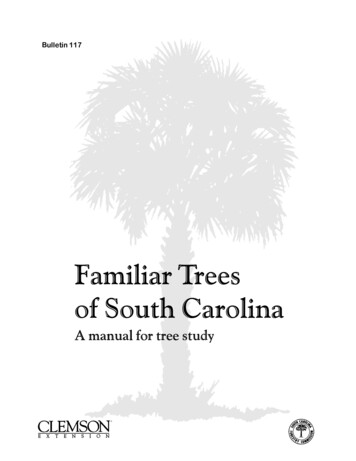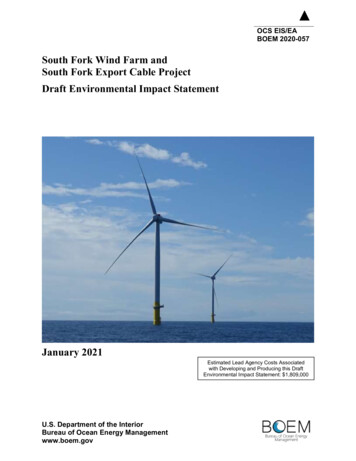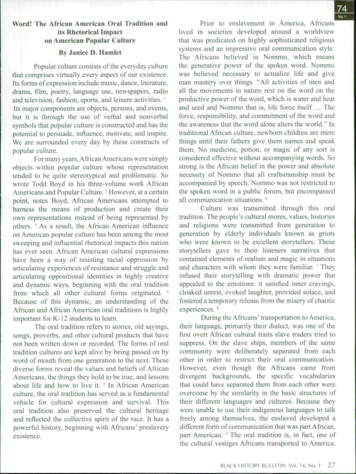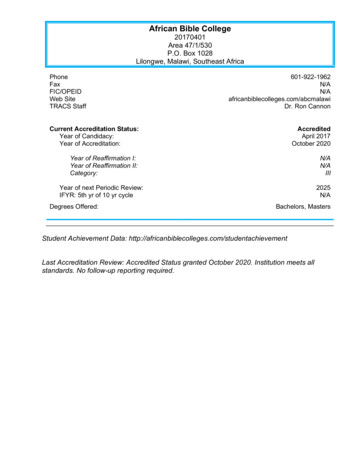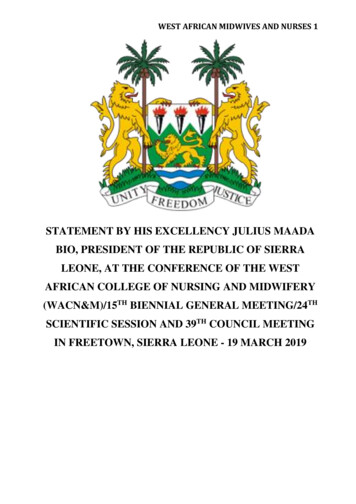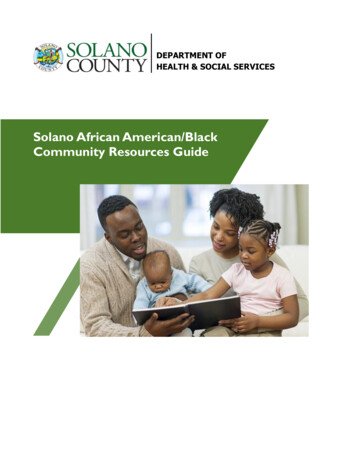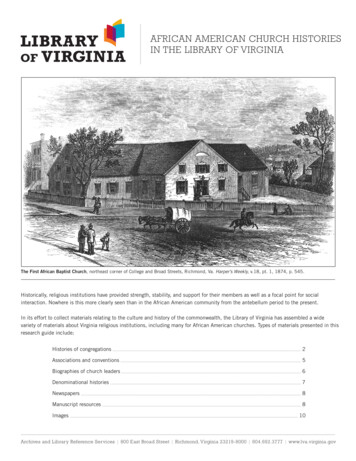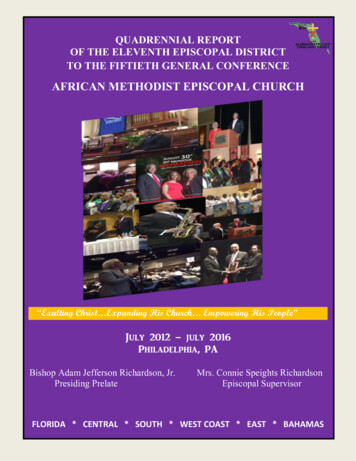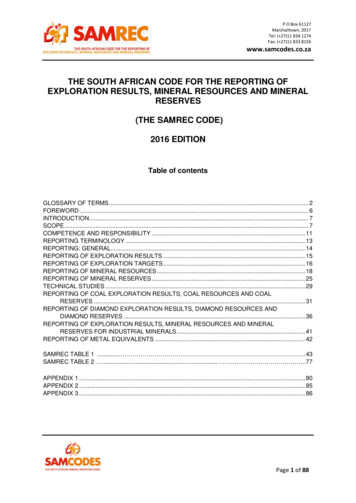
Transcription
P.O Box 61127Marshalltown, 2017Tel: ( 27)11 834 1274Fax: ( 27)11 833 8156www.samcodes.co.zaTHE SOUTH AFRICAN CODE FOR THE REPORTING OFEXPLORATION RESULTS, MINERAL RESOURCES AND MINERALRESERVES(THE SAMREC CODE)2016 EDITIONTable of contentsGLOSSARY OF TERMS . 2FOREWORD . 6INTRODUCTION. 7SCOPE . 7COMPETENCE AND RESPONSIBILITY . 11REPORTING TERMINOLOGY . 13REPORTING: GENERAL. 14REPORTING OF EXPLORATION RESULTS . 15REPORTING OF EXPLORATION TARGETS . 16REPORTING OF MINERAL RESOURCES . 18REPORTING OF MINERAL RESERVES . 25TECHNICAL STUDIES . 29REPORTING OF COAL EXPLORATION RESULTS, COAL RESOURCES AND COALRESERVES . 31REPORTING OF DIAMOND EXPLORATION RESULTS, DIAMOND RESOURCES ANDDIAMOND RESERVES . 36REPORTING OF EXPLORATION RESULTS, MINERAL RESOURCES AND MINERALRESERVES FOR INDUSTRIAL MINERALS . 41REPORTING OF METAL EQUIVALENTS . 42SAMREC TABLE 1 . 43SAMREC TABLE 2 . .77APPENDIX 1 . 80APPENDIX 2 . 85APPENDIX 3 . 86Page 1 of 88
P.O Box 61127Marshalltown, 2017Tel: ( 27)11 834 1274Fax: ( 27)11 833 8156www.samcodes.co.zaGLOSSARY OF TERMSAuditA systematic and detailed examination of the Mineral Resourceand Mineral Reserve, processes of estimation (includinggeological, geotechnical and other models), assumptions andconclusions undertaken in order to validate theappropriateness of the various components that contribute tothe estimates of the Mineral Resource and Mineral Reserve.An Audit includes a detailed examination of the base data andvalidation of the Mineral Resources and Reserves estimates.When compliance with the SAMREC Code is declared andsigned off, the audit must have been conducted by aCompetent Person.The Companies ActThe Companies Act No. 71 of 2008 of the Republic of SouthAfrica, as amended, or any law that may wholly or in partreplace it from time to time.Competent Person’sReport (CPR)A report on the technical aspects of a project or mine preparedby a Competent Person (CP). The contents are determined bythe nature/status of the project/mine being reported and mayinclude a techno-economic model as appropriate for the levelof study.Dilution /ContaminationLow or zero grade (waste) material that is mined during thecourse of mining operations and thereby forms part of theMineral ReserveEffective DateThe date of the most recent scientific or technical informationincluded in the technical reportHistorical EstimateAn estimate of the quantity, grade, or metal or mineral contentof a deposit that an issuer has not verified as a current MineralResource or Mineral Reserve. The estimate predates theissuing of the Code and/or was prepared before the issueracquiring, or entering into an agreement to acquire, an interestin the property that contains the deposit.Kimberlite IndicatorMinerals (KIMs), DiamondIndicator Minerals (DIMs)Garnet, chrome spinel, ilmenite and chrome diopside havingthe requisite chemical and physical properties that distinguishthem from otherwise similar minerals found in non-diamondassociated rock types.Life of Mine PlanA design and financial/economic study of an existing operationin which appropriate assessments have been made of existinggeological, mining, metallurgical, economic, marketing, legal,environmental, social, governmental, engineering, operationaland all other Modifying Factors, which are considered inPage 2 of 88
P.O Box 61127Marshalltown, 2017Tel: ( 27)11 834 1274Fax: ( 27)11 833 8156www.samcodes.co.zaGLOSSARY OF TERMSsufficient detail to demonstrate that continued extraction isreasonably justified. Refer to Table 2 for guidance.Licence, Permit, Right,Lease or similarentitlementAny form of licence, permit, right or lease, or other entitlementgranted by the relevant Government in accordance with itsmining legislation that confers on the holder certain rights toexplore for or extract minerals (or both) that might be containedin the designated area. Alternatively, any form of title that mayprove ownership/tenure of the minerals.MaterialCircumstances are considered material if omission ormisstatement of the associated factor, constituent orinformation could influence the economic decisions of users.As a rule of thumb, this difference would normally be equal toor exceed 10%.Material InformationMaterial information is any information relating to the businessand affairs of a company that results in or would reasonably beexpected to result in a significant change in the market price orvalue of any of the company’s assets. Material informationconsists of both material facts and material changes related tothe business and affairs of a company.MicrodiamondsDiamonds typically less than 0.5 mm that are recovered fromsamples by total liberation. Microdiamonds are used tounderstand and predict the diamond size distribution in primarydiamond deposits.MineableThose parts of the orebody, both economic and uneconomic,that can be extracted during the normal course of mining.Mine DesignA framework of mining components and processes taking intoaccount such aspects as mining methods used, access to theorebody, personnel and material handling, ventilation, water,power, and other technical requirements, such that mineplanning can be undertaken.Mine PlanningProduction planning and scheduling, within the Mine Design,taking into account such aspects as geological structures andMineralisation and associated infrastructure and otherconstraints.Mineral Deposit (orDeposit)A mass of naturally occurring mineral material, usually ofeconomic interest, without regard to mode of origin. Nocommercial value is implied.Page 3 of 88
P.O Box 61127Marshalltown, 2017Tel: ( 27)11 834 1274Fax: ( 27)11 833 8156www.samcodes.co.zaGLOSSARY OF TERMSMineral OccurrenceAny solid mineral of potential economic interest in anyconcentration found in bedrock or as float; especially avaluable (or potentially valuable) mineral in sufficientconcentration to suggest further exploration.MineralisationA concentration (or occurrence) of material of possibleeconomic interest, in or on the Earth’s crust, for which quantityand quality cannot be estimated with sufficient confidence to bedefined as a Mineral Resource. Mineralisation is not classifiedas a Mineral Resource or Mineral Reserve and can only bereported under Exploration Results. The data and informationrelating to it must be sufficient to allow a considered andbalanced judgement of its significance.mineralisationThe process or processes by which a mineral or minerals areintroduced into rock, resulting in a potentially valuable deposit.It is a general terms, incorporating various types, e.g. fissurefilling, impregnation, replacement, etc.Ore ReserveAlthough the term Mineral Reserve is used throughout thisCode, it is recognised that the term Ore Reserve is still ingeneral use. For the purposes of reporting under the SAMRECCode, these terms are considered to be synonymous.Residue / low gradestockpile / tailingsMaterial resulting from mining or processing operations.ReviewA systematic and detailed inspection or examination of anyelement of the Mineral Resource and/or Mineral Reserveestimation process undertaken in order to validate adherenceto standards and procedures, identify material errors and/oromissions or improvements. A review might include a detailedexamination of the base data. When compliance with theSAMREC Code is declared, the review must have beenconducted by a Competent Person.Recognised ProfessionalOrganisation (RPO)A RPO must:1.Be a self-regulatory organisation covering professionals inmining or exploration or both;2.Admit members primarily on the basis of their academicqualifications and experience;3.Require compliance with the professional standards ofcompetence and ethics established by the organisation;Page 4 of 88
P.O Box 61127Marshalltown, 2017Tel: ( 27)11 834 1274Fax: ( 27)11 833 8156www.samcodes.co.zaGLOSSARY OF TERMS4.Have disciplinary powers, including the power to suspendor expel a member; and5.Have been accepted by SSC Committee as an RPO.SAMRECThe South African Mineral Resource CommitteeSAMVAL CommitteeThe South African Mineral Asset Valuation Committeesignificant projectAn exploration or mineral development project that has orcould have a significant influence on the market value oroperations of the listed company, and/or has specificprominence in Public Reports and announcements.SSC CommitteeThe SAMREC/SAMVAL CommitteePage 5 of 88
P.O Box 61127Marshalltown, 2017Tel: ( 27)11 834 1274Fax: ( 27)11 833 8156www.samcodes.co.zaFOREWORD1The SOUTH AFRICAN CODE FOR THE REPORTING OF EXPLORATION RESULTS,MINERAL RESOURCES AND MINERAL RESERVES (the SAMREC Code, or theCode) sets out minimum standards, recommendations and guidelines for PublicReporting of Exploration Results, Mineral Resources and Mineral Reserves in SouthAfrica. It has been drawn up by the Working Group of the SSC Committee under thejoint auspices of the Southern African Institute of Mining and Metallurgy (SAIMM) andthe Geological Society of South Africa (GSSA). The SSC consists of representatives ofthe SAIMM, the GSSA, the South African Council for Natural Scientific Professions(SACNASP), the Geostatistical Association of South Africa (GASA), the South AfricanGeomatics Council (SAGC), the Institute of Mine Surveyors of Southern Africa(IMSSA), the Association of Law Societies of South Africa, the General Council of theBar of South Africa, the Department of Mineral Resources (DMR), the JSE Limited(JSE), the Council for Geoscience, the Banking Association of South Africa, Directorateof Mineral Economics/Minerals Bureau, the Chamber of Mines of South Africa (CoM),South African Institute of Chartered Accountants (SAICA) and the Investment AnalystsSociety of South Africa (IAS).The first version of the SAMREC Code was issued in March 2000 and adopted by theJSE in their Listings Requirements later that same year. The Code has been adoptedby the SAIMM, GSSA, SACNASP, ECSA, IMSSA and SAGC, and it is binding onmembers of these organisations. For background information and the history of thedevelopment of the Code, please refer to the SAMREC Code, March 2000. A secondedition of the SAMREC code was issued in 2007 with an amendment being issued in2009. This 2016 edition supersedes the previous editions of the Code.Concurrently with the evolution of the SAMREC Code, the Committee for MineralReserves International Reporting Standards (CRIRSCO), initially a committee of theCouncil of Mining and Metallurgical Institutions (CMMI), has, since 1994, been workingto create a set of standard definitions for the reporting of Mineral Resources andMineral Reserves.As a result of the CRIRSCO/ICMM initiative, considerable progress has been madetowards widespread adoption of globally consistent reporting standards. These areembodied in similar Codes, guidelines and standards published and adopted by therelevant professional bodies around the world.The definitions in this edition of the SAMREC Code are either identical to, or notmaterially different from, those existing standard definitions published in the CRIRSCOReporting Template 2013.Page 6 of 88
P.O Box 61127Marshalltown, 2017Tel: ( 27)11 834 1274Fax: ( 27)11 833 8156www.samcodes.co.zaINTRODUCTION2The Code is applicable to the reporting of all styles of solid mineralisation or economicdeposit. Certain commodities, namely coal, diamonds/gemstones and industrialminerals, have specific additional reporting requirements and these are dealt with fromClause 48 onwards. The Code does not apply to oil, gas or water. The South AfricaOil and Gas Code (SAMOG) is applicable for oil and gas.In this third edition of the SAMREC Code, which supersedes all previous editions, theCode is presented predominantly in normal typeface. Definitions are highlighted inbold text and form part
Reporting of Exploration Results, Mineral Resources and Mineral Reserves in South Africa. It has been drawn up by the Working Group of the SSC Committee under the joint auspices of the Southern African Institute of Mining and Metallurgy (SAIMM) and the Geological Society of South Africa (GSSA). The SSC consists of representatives of
